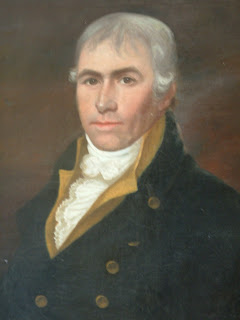Anna
Cromwell was the daughter of Lord Protector Richard Cromwell (or Tumbledown
Dick as he known due to the brevity of his time in office) and granddaughter of
Oliver Cromwell. She was actually born
during the year of her father’s protectorate but would have grown up during the
restoration. Not much is known about her;
she inherited considerable wealth from her family, was close to her older
unmarried sister Elizabeth, married the physician Thomas Gibson, had no
children and died at the age of 68 in 1727. One contemporary, Hewling Luson
wrote of the two Cromwell sisters “I have been several times in company with
these ladies. They were well-bred, well-dressed, stately women, exactly
punctilious; but they seemed, especially Mistress Cromwell, to carry about them
a consciousness of high rank, accompanied with a secret dread that those with
whom they conversed should not observe and acknowledge it. They had neither the
good sense nor the great enthusiasm of Mrs. Bendysh. But as the daughter of
Ireton had dignity without pride, the daughters of Richard Cromwell had pride
without much dignity." (Bridget Bendish was the daughter of Henry Ireton
and Oliver Cromwell’s daughter Bridget, and was therefore cousin to Anna and
Elizabeth).
 |
| Dr Edmund Gibson, Bishop of London nephew and heir |
The
Oxford antiquarian Thomas Hearn also mentions
the two sisters in a diary entry from 1719; “On Saturday, 5 September,
came to Oxford two daughters of Richard Cromwell, son of Oliver Cromwell,
Protector, one of whom is married to Dr. Gibson, the physician, who wrote 'The
Anatomy'; the other is unmarried. They
are both Presbyterians, as is also Dr. Gibson, who was with them. They were at
the Presbyterian Meeting-house in Oxford on Sunday morning and evening ; and
yesterday they and all the gang with them dined at Dr. Gibson's, the Provost of
Queen's, who is related to them, and made a great entertainment for them,
expecting something from them, the physician being said to be worth £30,000.
They went from Oxford after dinner." John Gibson, the Provost of queen’s,
was Thomas Gibson’s nephew. His hopes of a share in his uncles £30,000 fortune
were to be thwarted. After her husband
died another relative of his, Dr Edmund Gibson, the Bishop of London, was very
attentive to Anna, supposedly even writing a “Life of Cromwell” to please her
(though it was of course published anonymously, the king was the head of the
church after all). He didn’t need to make the effort; Thomas’ will had specified
that Edmund was to inherit after Anna’s death but perhaps he was genuinely fond
of her.
Thomas
Gibson was born in Bampton, near Penrith in Cumbria around 1648. He attended
university at Cambridge and at Leyden in the Netherlands and was admitted a
licentiate of the Royal College of Physicians on 26 June 1676, and an honorary
fellow on 30 Sept. 1680. On 21 January 1719, at the age of 71, he was appointed
physician general to the army. He married twice, the first time to Elizabeth
the widow of Zephaniah Cresset of Hertfordshire and the second time, in 1698
when he was fifty and she was 39, to Anna Cromwell. There were no children from
either marriage. Gibson is chiefly remembered for his ‘Anatomy of Humane Bodies
epitomized’ published in 8 volumes in 1682. The fact that the work was largely
plagiarised from the work of Alexander Reid, amongst others, did not stop it
being either popular or often reprinted. Not all of his ‘Anatomy…’ though was
completely unoriginal as his section on The
Clitoris shows:
Above, betwixt
the nymphae, in the upper part of the pudendum does a part jet out a little
that is called clitoris, from [the Greek] that signifies lasciviously to grope
the pudendum. It is otherwise called virga, for it answers to a man’s yard in
shape, situation, substance, repletion with spirits and erection, and differs
from it only in length and bigness. In some it grows to that length as to hang
out from betwixt the lips of the privity. Yea, there are many stories of such
as have had it so long and big as to be able to accompany with other women like
unto men, and such are called fricatrices, or otherwise, hermaphrodites; who it
is not probable are truly of both sexes, but only the testes fall down into the
labia, and this clitoris is preternaturally extended. But in most it jets out
so little as that it does not appear but by drawing aside the labia.
Its use may be
known from what has already been discoursed. And we will note further that in
some Eastern countries it uses to be so large, that for its deformity and the
hindrance it gives to copulation, they use to cut it quite out, or hinder its
growth by searing it, which they improperly call circumcision.
 |
| Georges Arnauld de Ronsil, Dissertation sur les hermaphrodites, 1750 |





























